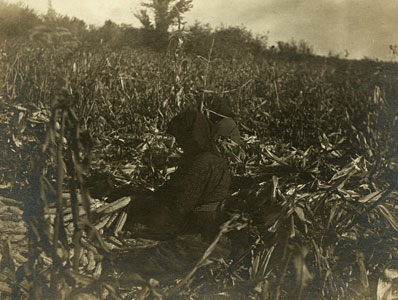
Husking Corn in the field SHSND# 0086-280The arrival of Europeans and European Americans wrought changes in the culture of the Hidatsa and Mandan including gardening. Metal hoes may have been the first noticeable change which while not universally welcomed did bring some improvements in the hard work of hoeing and maintaining the tools to those who chose to use them. In the early years of contact, the Mandan and Hidatsa offered corn and other foods to travelers from their surpluses. European Americans called the corn grown by the Mandan, Hidatsa, and Arikara “squaw corn” to indicate their disdain for people who allowed women to work in the fields (they were blind to the field work of European American women). The corn was unlike what they had grown in eastern and mid-western states such as Illinois and Indiana. The ears were generally smaller and often grew close to the ground. However, the corn varieties growing along the Missouri River were well adapted to this climate. (Will, Corn, p. 21, 24)
Officers assigned to northern Plains posts during the 1870s observed and tasted the corn grown in the earthlodge villages. They found it useful for feeding soldiers and horses and it was cultivated at Fort Buford in the 1870s. Soldiers and settlers did not apply the same harvesting and cooking methods to the native corn they grew and probably found it unsatisfying by comparison to what they remembered from their eastern homes.




